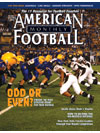AMERICAN FOOTBALL MONTHLY THE #1 RESOURCE FOR FOOTBALL COACHES
Article CategoriesAFM Magazine
|
Dynamic Stretching during Warm-Up?by: Carol J.M. Clein, MBA, MS, CSCSBoyd H. Anderson High School, Lauderdale Lakes, Florida © More from this issue On almost every football field in America, at some point before practices and games, the teams line-up and static stretch. Football teams have always done it, so what is the problem? The problem is that if anyone responsible for those football teams was asked why they are static stretching, they will probably not be able to offer a reason that is supported by current research. Is there a better activity to include in the warm-up? Dynamic stretch can generally be defined as controlled, steady movements through the range of motion that would be achieved by each joint during the activity. Static stretching involves reaching and holding at a point of slight discomfort. Ideally, warm-up for a sport should include activities that prepare the body for the sport, improve performance – or at the very least, not negatively impact performa....The full article can only be seen by subscribers. Subscribe today!
|
|
|||||||
| HOME |
MAGAZINE |
SUBSCRIBE | ONLINE COLUMNISTS | COACHING VIDEOS |
Copyright 2025, AmericanFootballMonthly.com
All Rights Reserved





